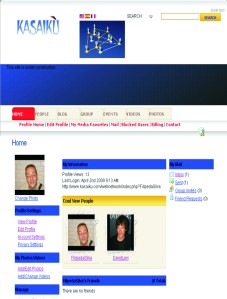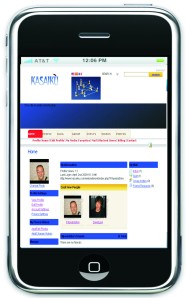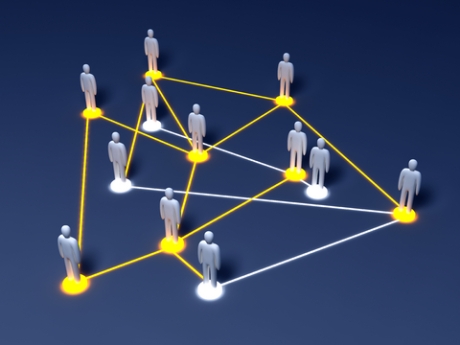Kasaiku a new social network for business
 Kasaiku is the brand new player on planet social network. It enters into the category of business networks such as Linkedin, Plaxo, Naymz or Xing, but the difference is on its content and the way it is presented, bit more linke Facebook or Bebo. It provides its users several applications: live chat, the possibility to create groups, events, post pictures or business video’s or even video CV’s which is the brand new way to show talented people their skills by presenting themselves in a 2 minute video appearance. Everyone can be traced, connected and invited. A mashup permits to use Google maps for events or to locate friends.
Kasaiku is the brand new player on planet social network. It enters into the category of business networks such as Linkedin, Plaxo, Naymz or Xing, but the difference is on its content and the way it is presented, bit more linke Facebook or Bebo. It provides its users several applications: live chat, the possibility to create groups, events, post pictures or business video’s or even video CV’s which is the brand new way to show talented people their skills by presenting themselves in a 2 minute video appearance. Everyone can be traced, connected and invited. A mashup permits to use Google maps for events or to locate friends.

Its CEO Filipe de Sousa is optimistic about the future, Kasaiku will be a reference for business and for job search, the easy search bottom permits anyon find other kasaiku profiles and inviting them to become friends but also companies can be invited and vice versa, in order to increase business opportunities. Kasaiku plans to use Virtual worlds in the future in order to organize virtual business meetings or job interviews.
Kasaiku.com has all the ingredients to become a success story.
to register : http://www.kasaiku.com/webnetwork/index.php?page=register

Kasaiku on Iphone
Social network classified

Social networks can be classified into 7 categories based on their purposes:
- Love and dating networks
- Friendship networks
- Business networks
- Job and Talent networks
- Communities (based on branding and companies, groups and fan clubs) and Knowledge networks
- Games networks
- Virtual worlds
The first kind of networks are Love and dating networks were amongst the first kind of online networks such as “meetic” or “Date.com” . It allowed users to find their matching in love. It was directly followed by more adult sites such as “Adult finder”. Love sites were immediately accepted by the public due a lack of social behaviour of urban youth. Millions of people around the world registered to those dating sites in order to find their love mate. According to Gartner, this sites are came into a mature fase in 2004.Today must of the people tend to seek their future love mate through Facebook or myspace were you have a broad view of the personality of the person you try to contact, sort of “tell me how are your friends and I tell you who you are”
Dating sites does not give a clear view of the person behind the profile thus the person can enter a false identity or even lie about his characteristics.
The second kind of networks who followed closely and logically the dating sites are “friendship networks” . The first to emerge were Classmates in 1995 and Friendster. Both are still found on the web besides being surpassed by younger social networks such as Myspace, Netlog or Facebook. Mainly due to the lack of a Multilanguage platform, but also from funny applications and friendly graphical structure. Myspace is considered to be a revolution in social networks and are considered to be the MTV of the web because musical talent can be discovered. Indeed Myspace is for the web what MTV was in the eighties in the music industry, Deejays, Musicians, singers and others gather together to share talent and promote talent. Must of this friendships sites started with students and developed into a more mature fase, first because those same students became part of the work system but also they spread the word and the trend (Facebook phenomenon). One thing in particular became clear for employees in their companies, youth organized quicker a party in a view clicks on Facebook than employees on outlook for their work meetings ! It became clear that the next level of network would be for professional purpose, therefore we come into the Third kind of network; “Business networks”.
It is clear that people inside companies had the necessity to keep track of their former employees not only for friendship but for sharing knowledge and to know what they had become. Sites like Linkedin, Xing, Plaxo, Viadeo and Naymz are sites were you can upload your curriculum on your profile. You become traceable to anyone who is interested your profile, whether it is for a career opportunity, a reference, a business deal or an introduction to a service or a product, once you are on a business site you are their because you want to be seen. Business sites can be defined into two kinds of networks, close networks and open networks. Close networks, users can only subscribe by invitation, asmallworld.com is a good example, this website was created for and by elite people in Europe, someone inside has the opportunity to invite a definite number of persons. Its users trade luxury goods and gather for special events.
Open networks concede a free registration to all users. Once registered users have several tools to search, contact and collaborate into different levels of the network. Even here free users have limitations, in order to monetize these networks, premium account have been created in order to permit its members to contact anyone inside the network without limitation. Linkedin provides its premium users only 5 INmails per month, that if not used can be added to the next month.
Viadeo and Xing have a different approach they allow their premium members to use fully their tools without limitation.
Since these networks have profiles of millions of professionals whom are passively open for career opportunity, several Recruitment firms used these tools in order to scout talents globally. Which resulted in the necessity to add job boards and company profiles to promote employer branding. This eclipsed jobsites such as Stepstone, Monster and Careerbuilder, who are changing their business models into a more friendly and social model.
The other kind of business network is “Ecademy” (which was found by Thomas Power) based in the UK. This is a “must be” for business. You can find investors or locate partners, create join ventures and find clients for your product and services. For a small fee users can benefit from their premium “Blackstar” account and be promoted on the network.
Job and Talent networks are similar to business networks, but are specialize into career opportunities. In this category you can find the renewed classical job and talent sites such as Careerbuilder or Monster and Stepstone but also freshly and more friendly sites such as Zumeo or Kasaiku. The registration of these sites are free, the only fee asked is for job posting by companies. Since these sites are specialized into career opportunities, they provide companies tools and application in order to facilitate their search for talent. On the other hand they have sophisticated tools for jobseekers in their search for jobs.
Communities is a category where I regrouped all the websites where people can innovate, share, collaborate to its content or develop its structure. These communities regroup people with the same interest or the with the same goals. It can be divided into two kinds, close communities, which can be companies or closed groups communities such as enterprise 2.0 where a group of people work together virtually for a common goal or even groups of scientist working for a purpose such as sharing knowledge or innovation “Innocentive”. The other kind are open communities where companies meet their client communities in order to promote its brand experience “Coca Cola, Procter & Gamble”. In open communities you can find all the other networks of common collaboration and sharing such as Flickr, Youtube , Wikipedia , Slideshare, Amazon and EBay. These communities are fundamental for crowdsourcing purposes.
Games network are simply communities inside online games who contribute to its development and knowledge (blogs, wikis) These are closed networks where only the game fan finds himself and speaks in name of his or her character in the game, it can be classified into virtual worlds I prefer not, due to its specific role on gaming. What I intend by virtual worlds are online 3D worlds without a specific attached scenario, where the user is free to follow its own story. Such as Second life or Moondus these networks can be defined as the 7 type of networks
Do you want to build your social network?

Thinking of building a social network
When we see the huge success behind several social networking sites, we cannot hide behind our desire to create one of our own, telling that its a goldmine to be explored. The truth is, it is not so easy. Facebook has its success, due to its unique way to present its applications to its users. Linkedin has its success because it is the first site to mix your profile and your career path in order for you to promote yourself and your business to the world. Myspace is a place where you can upload music, videos, get to know people with the same passion as you.
Every social network has its own way to contact its users. SO, if you want to create a social network platform you need to create something Unique, not like facebook or myspace or netlog. Creating an original general site is the only way to distinguish from the others. You don’t need to register to another social network if all of your friends are already on facebook, if the answer is yes, I will register, how many of my friends will follow me?
But if you create something completely different, than maybe it will grow.
Another problem is technology, unless you are a programmer yourself and you have time, you can program the site with all its complexity. The technology behind web 2.0 is more complex than just creating a website with html or css language, add with some flash or javascipts. NO, interactive web needs a platform with more memory than you ever could imagine. PHP, CSS, RSS, XHTML, wiki, JAVA are few of those web 1.0 and web 2.0 languages you can use in order to create your social network site.
I have interviewed many of the founders of social communities sites and the major problem is to keep on with the sustainability of the site. It means that you need to keep buying servers in order to keep up with the growing number of profiles, sometimes without receiving any money from advertisement . Wikipedia for example, since it is a not profit organization receives donations from its users and developers ! mass collaboration !
Facebook has monetize it with its applications (that for some are merely recognizable as advertisements)
Linkedin has recently started with advertisement but receives part of its revenue from companies who would like to use this professional tool to promote its employer branding and premium membership, which allows a better use of its applications.
Another weakness is the cost of creating such platform, starting with a minimum of 10,000 $ for programming.
The jungle is tight and there is little sunshine left to grow. Few have failed and have perished in the race.
According to Lorenz Bogaert, founder and CEO of Netlog, at the moment we are assisting to a mature face of evolution of online social networking, the whole is becoming monetized. The only possible way to gain profit is by finding ways to monetize its use, like opening a shop inside a shopping mall and make it profitable.
A few have done it with linkedin such as the registration to groups such as InvitesWelcome.com (Open Networkers) or GroupLinked.com or LION500.com (Open Networkers) and TopLinked.com (Open Networkers).
I would not recommend to build a social network but if you need to create one, a niche than I would recommend Linkedin groups or NING, which is a online self building social network with all its feature, it is free but you cannot gain money cause you do not own the site.
How to recruit on Linkedin?
Linkedin has been used for different applications:
* For business purpose: finding new join ventures, business partners, client search
* For Knowledge Management: Gathering information about companies and its turnover
* Sharing knowledge: groups of engineers or scientists gathering together to share information
* Job search: searching the right job or being found by a recuiter.
* Job matching or Recruiting: Searching for workforce
Linkedin provides several tools in order to facilitate the search of interesting profiles.
But first let me give you some tips about the type of profile you can find on Linkedin:
Since people register on Linkedin for different purposes, not all are interested in being contacted for a job. Every person can edit his contact settings which can be showed on its profile:
Contact Settings
Interested In
- career opportunities
- consulting offers
- new ventures
- job inquiries
- expertise requests
- business deals
- reference requests
- getting back in touch
Basically without any charge you can search for profiles on Linkedin, if the person has filled his career path than you have an overview of his resume.
Click on “Advanced People Search”:

The Advanced search permits you to have an overview of keywords and fields that will facilitate your search:

When you have filtered the search, a shortlist will be presented.
The search can be saved, allowing to receive a feedback from the system in case another profile will match your request by email.
How to contact a profile ?
* You can send an INmail: INmails are internal messages on Linkedin, you can send and receive inmails. It can be viewed on your “inbox” left of your “profile” or “home” screen. Inmails can only be used by premium members that have 3 to 5 Inmails per month, if not used, it can save them.
* You can be introduced to a profile: Relying on someone who is connected to you on the first degree, asking that person to introduce you to the desired person who is connected to him or to someone that is directly connected. Sort of word to mouth message.
* Invite the desired person to be connected to you: Linkedin has a privacy policy, that states that you can only invite someone if you really know that person. Several recruiters have a problem by using this tool. You can either state that this person has worked or done business together or either know his or her email address. The invited person has the choice to archive your request, to deny by clicking “I don’t know that person” or to accept your request.
N.B. mostly people interested in career opportunities will accept your request if interested (therefore showing their curiousity towards your offer).
In the case a person does not accept your invitation than the system will register denials and will block you from invitation without the person’s email address, explaining that several denials have been registred.
In this case, you will have to send an email to the customer service.
Suitable letter for invitation:
Invitation letters must be informal and personalized. The invited person must feel the interest regarding his or her profile. You must provide you coordinates in order to be contacted: tel number, company email, mobile, website, etc.
Linkedin has also create a tool dedicated to companies and recruiters:
Linkedin Corporate Solutions or Linkedin recruiter:

This tool (cost around 30,000 $ or more) allows the recruiter to search any profile on the Linkedin network. The recruiter has the possibility to create job slots on the marketplace of Linkedin jobs (see next article about Linkedin jobs).
You have the possibility to save you search into folders left of the window and bookmarking the interesting profiles.
This application allows you to contact people, with 250 inmails per month.

The corporate solution provides a company a certain visibility in order to improve its employer branding by creating a company profile.
The company profile provides users with information about the company such as location, updated stocks, who’s who on Linkedin, latest promotions or hired people. It is a very useful information for recruiters for Market intelligence purposes. ( you don’t need a corporate account to view company profiles)
You can view company profiles by clicking on Company:

In order to have good results in recruitment in Linkedin you need to be connected to a lot of people, therefore most of the recruiters on Linkedin are connected to a whole world of people, millions and millions of potential candidates !!! Thus my final words are: Connect yourself to the world !!!
The Excellence of being Linkedin side a business network part 2
Linkedin population:
As you may already know you cannot see entirely other profiles if they are not connected to your network (till the 3d degree) therefore it is important to connect to “open networkers”. These profiles allow you to access their professional network till their second degree of separation, which becomes your 3d degree network. “Open Networkers” are social connectors hungry for connections! they allow everyone to connect with them and they send invitations all along to be at the center of a major hub of connections. To define the population of Linkedin we need to focus on their behavior. Linkedin is at the moment by far the most visited business network on the Web planet with more than 30 million registrations. The truth is that a lot of this connection are not actively networking but have just a presence inside the network. I call them “Passive Users“, They have a connection or two, are not involved in any group or do not participate at questions or polls inside the network. They just have a profile with little information about their experience, study and they are not open to contact at any level. The second type of users are the “Open minded” users, they have a full profile and are frequently using Linkedin as a platform to talk with their colleagues (even with competitors).
With the purpose to share knowledge. For this type of profile, the exchange of information is crucial for the development of its projects. They can accept any job offer but is not actively seeking. They have a network between 50 and 250 direct connections and an estimate of 130,000 connections in the second degree of separation
The last type of users are the “Open Networkers”, as I told previously they are active users of Linkedin, they are connected to thousands and thousand (some more than 15,000) in direct connection. They have a visibility near to the total some of registration (Jan 2009 30 million).
How to search a profile:
Here is a video that permits you to search a profile,by name:
http://www.new.facebook.com/video/video.php?v=1104816257657&oid=73545559672
The exellence of being LINKEDIN side a business network part 1

- Linkedin logo
Linkedin was founded in 2002 but launched in May 2003 by an ex executive of Paypal Reid Hoffman. Linkedin is a social network with a more business purpose. It links professionals around the globe, today (January 2009) it has more than 30 million online profiles and it is the twelfth most visited social network site. It differs from Myspace and Facebook by its population and the purpose of linking network.
 This is the main bar menu
This is the main bar menu-
Archives
- May 2009 (1)
- April 2009 (4)
- March 2009 (4)
- February 2009 (5)
- January 2009 (4)
-
Categories
-
RSS
Entries RSS
Comments RSS

